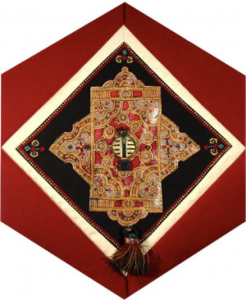Mauritania

The Block
The warmth emanating from the saturated tones painted on leather recalls Mauritania’s seemingly endless desert communities. Mauritanians are renowned for their exquisite leather-work, and this piece, cut from a traditional ottoman, features complex, geometric shapes, all painted freehand. According to blockmaker Mme. Mint-Amara, the design is typical of patterns used in jewelry, woodwork, embroidery, carpets and the currency. They are also drawn on the hands and feet of Mauritian women. A decorative carved ebony and brass piece enhances the work, which is framed by a cross-stitch border. Fine pieces of painted and twisted leather form a finishing tassel, an embellishment used extensively on items such as wallets, purses and belts.
Cultural Profile
Mauritania lies across one of the great trans-Saharan trade routes on the west coast of Africa. It is the site of what is sometimes referred to as ‘The Eye of Africa,’ a huge crater, which is 50 kilometres in diameter and easily visible from space. This land was once covered in lush, tropical forests and had enough vegetation to support an abundance of elephants, rhinos and hippos. Now, Mauritania (formerly part of French West Africa) is more than half covered by the Sahara Desert. The main agricultural regions are in the southern Senegal River Valley, with the rest of the country made up of a semi-desert area known as the Sahel. The majority of the population is comprised of nomadic and semi-nomadic people of Berber, Arab, Tuareg and Fulani descent. Those of Berber, Arab or mixed Berber-Arab background are sometimes called Moors (or Maurs). The remainder of the population is Black Africans, most of whom belong to the Tukolor, Pulaar, Soniké, Bambara and Wolof ethnic groups. They pursue an agricultural life along the river. Severe droughts in the 1970s and 1980s forced many nomads, who then accounted for over 80% of the country’s population, into more urban areas. The official language is Hassaniya Arabic, although other indigenous tongues, such as Wolof, Pulaar and Soniké, are recognized languages. French is widely spoken. Mauritanian culture is a combination of Berber, Islamic, French and sub-Saharan African influences. Music plays an important role in daily life. The tidnit, a four-stringed lute, is one of the traditional instruments used. Mauritanians also participate in the West African tradition of the griots, or djelis, storytellers and musicians who act as historians and negotiators between parties if needed. Traditionally, djelis are part of a cast: their knowledge is transmitted from father to son, and a djeli can only marry the daughter of another djeli. The ardin is a harp played by women, who often perform in public though they are not ‘officially’ considered griots. Numerous women have achieved celebrity status in the country with their music. Almost all traditional elements in Mauritanian culture are related to the historic nomadic lifestyle. Traditional clothing is made of long cotton pieces wrapped around the head and the face to protect from the fierce sun and blowing sand. Clothes are usually dyed with indigo, which leaves stains on the wearer’s hands or face, often considered beauty marks. The tents of the Moors, called khaimas, are made of country cloth, narrow cotton strips, are sewn together by women. Tents are indeed so important in the local culture that, even though more and more Mauritanians now live in cities, tents are still erected on unused urban land during election times to serve as campaign centers. Traditional handcrafts include a wide variety of jewelry making, metal working, woodworking and the making of glass beads. Textile arts include spinning, weaving, indigo dyeing and the making of country cloth. People have been coming to Canada from Mauritania since 1946. Many have been factory workers or trades people who settled in Ontario, Québec, the Maritime provinces, Manitoba and Saskatchewan
Sponsor: Linda Halliday and Bob Copeland
